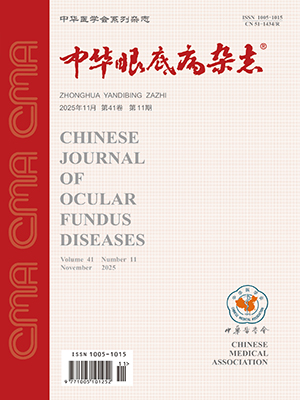| 1. |
Sigford DK, Reddy S, Mollineaux C, et al. Global reported endophthalmitis risk following intravitreal injections of anti-VEGF: a literature review and analysis[J]. Clin Ophthalmol, 2015, 9: 773-781. DOI: 10.2147/OPTH.S77067.
|
| 2. |
Ma H, Wei H, Zou C, et al. Anti-VEGF drugs in age-related macular degeneration: a focus on dosing regimen-related safety and efficacy[J]. Drugs Aging, 2023, 40(11): 991-1007. DOI: 10.1007/s40266-023-01068-8.
|
| 3. |
Davidov B, Ohayon A, Trivizki O, et al. Postintravitreal injection endophthalmitis: incidence, characteristics, management, and outcome[J/OL]. J Ophthalmol, 2023, 2023: 9212524[2023-11-06]. https://pubmed.ncbi.nlm.nih.gov/37965437/. DOI: 10.1155/2023/9212524.
|
| 4. |
Simina DS, Larisa I, Otilia C, et al. The ocular surface bacterial contamination and its management in the prophylaxis of post cataract surgery endophthalmitis[J]. Rom J Ophthalmol, 2021, 65(1): 2-9. DOI: 10.22336/rjo.2021.2.
|
| 5. |
Lundström M, Friling E, Montan P. Risk factors for endophthalmitis after cataract surgery: predictors for causative organisms and visual outcomes[J]. J Cataract Refract Surg, 2015, 41(11): 2410-2416. DOI: 10.1016/j.jcrs.2015.05.027.
|
| 6. |
Fileta JB, Scott IU, Flynn HW Jr. Meta-analysis of infectious endophthalmitis after intravitreal injection of anti-vascular endothelial growth factor agents[J]. Ophthalmic Surg Lasers Imaging Retina, 2014, 45(2): 143-149. DOI: 10.3928/23258160-20140306-08.
|
| 7. |
李筱荣, 黎晓新, 许迅. 一站式玻璃体腔注药模式的建立与管理专家共识[J]. 中华眼底病杂志, 2023, 39(3): 187-193. DOI: 10.3760/cma.j.cn511434-20230211-00041.Li XR, Li XX, Xu X. One-stop intravitreal injection model: expert consensus on establishment and management[J]. Chin J Ocul Fundus Dis, 2023, 39(3): 187-193. DOI: 10.3760/cma.j.cn511434-20230211-00041.
|
| 8. |
谭亮章, 任新军, 柯屹峰, 等. 一站式玻璃体腔注药模式成立前后真实世界研究大数据对比[J]. 中华眼底病杂志, 2023, 39(6): 451-458. DOI: 10.3760/cma.j.cn511434-20230518-00226.Tan LZ, Ren XJ, Ke YF, et al. Comparison of big data before and after the establishment of one-stop intravitreal injection mode in the real-world research[J]. Chin J Ocul Fundus Dis, 2023, 39(6): 451-458. DOI: 10.3760/cma.j.cn511434-20230518-00226.
|
| 9. |
Bergamo VC, Nakayama LF, Moraes NSB, et al. Bacterial endophthalmitis following anti-VEGF intravitreal injections: a retrospective case series[J]. Int J Retina Vitreous, 2023, 9(1): 58. DOI: 10.1186/s40942-023-00490-9.
|
| 10. |
中华医学会眼科学分会眼底病学组, 中华医学会眼科学分会白内障及屈光手术学组, 中华医学会眼科学分会眼外伤学组, 等. 中国眼科手术后感染性眼内炎诊疗专家共识(2022年)[J]. 中华眼科杂志, 2022, 58(7): 487-499. DOI: 10.3760/cma.j.cn112142-20220301-00088.Chinese Vitreo-Retina Society of Chinese Medical Association, Chinese Cataract and Refractive Surgery Society, China Ocular Trauma Society of Ophthalmology Branch of Chinese Medical Association, et al. Chinese expert consensus on the diagnosis and management of infectious endophthalmitis after ophthalmic surgery (2022)[J]. Chin J Ophthalmol, 2022, 58(7): 487-499. DOI: 10.3760/cma.j.cn112142-20220301-00088.
|
| 11. |
Spaide RF. Method of povidone-iodine application and endophthalmitis risk[J]. Retin Cases Brief Rep, 2024, 18(2): 141-144. DOI: 10.1097/ICB.0000000000001367.
|
| 12. |
Casemiro JH, Oguido A, Casella AMB. Using 2% PVPI topical solution for serial intravitreous injections and ocular surface findings: a case control study[J]. Int J Retina Vitreous, 2024, 10(1): 41. DOI: 10.1186/s40942-024-00557-1.
|
| 13. |
Gower EW, Lindsley K, Tulenko SE, et al. Perioperative antibiotics for prevention of acute endophthalmitis after cataract surgery[J/OL]. Cochrane Database Syst Rev, 2017, 2(2): CD006364[2017-02-13]. https://pubmed.ncbi.nlm.nih.gov/28192644/. DOI: 10.1002/14651858.CD006364.pub3.
|
| 14. |
Lyall DA, Tey A, Foot B, et al. Post-intravitreal anti-VEGF endophthalmitis in the United Kingdom: incidence, features, risk factors, and outcomes[J]. Eye (Lond), 2012, 26(12): 1517-1526. DOI: 10.1038/eye.2012.199.
|
| 15. |
Halachmi-Eyal O, Lang Y, Keness Y, et al. Preoperative topical moxifloxacin 0.5% and povidone-iodine 5.0% versus povidone-iodine 5.0% alone to reduce bacterial colonization in the conjunctival sac[J]. J Cataract Refract Surg, 2009, 35(12): 2109-2114. DOI: 10.1016/j.jcrs.2009.06.038.
|
| 16. |
Schimel AM, Miller D, Flynn HW. Evolving fluoroquinolone resistance among coagulase-negative Staphylococcus isolates causing endophthalmitis[J]. Arch Ophthalmol, 2012, 130(12): 1617-1618. DOI: 10.1001/archophthalmol.2012.2348.
|
| 17. |
Mino De Kaspar H, Hoepfner AS, Engelbert M, et al. Antibiotic resistance pattern and visual outcome in experimentally-induced Staphylococcus epidermidis endophthalmitis in a rabbit model[J]. Ophthalmology, 2001, 108(3): 470-478. DOI: 10.1016/s0161-6420(00)00545-5.
|
| 18. |
Hou CH, Lee JS, Lin KK, et al. Risk and dose-response relationship of diabetes mellitus for endophthalmitis after cataract surgery in a nationwide cohort study in Taiwan[J]. Clin Exp Ophthalmol, 2023, 51(7): 692-703. DOI: 10.1111/ceo.14288.
|
| 19. |
Israilevich RN, Mansour H, Patel SN, et al. Risk of endophthalmitis based on cumulative number of anti-vascular endothelial growth factor intravitreal injections[J]. Ophthalmology, 2024, 131(6): 667-673. DOI: 10.1016/j.ophtha.2023.12.033.
|
| 20. |
Seong HJ, Park YM, Kim J, et al. Incidence of acute endophthalmitis after intravitreal antivascular endothelial growth factor injection in age-related macular degeneration[J]. Korean J Ophthalmol, 2022, 36(5): 435-442. DOI: 10.3341/kjo.2022.0088.
|




